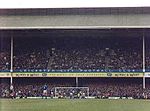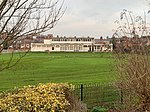King Power Stadium
2002 establishments in EnglandEnglish Football League venuesFootball in LeicestershireFootball venues in EnglandLeicester City F.C. ... and 7 more
Leicester City W.F.C.Premier League venuesRugby union stadiums in EnglandSports venues completed in 2002Sports venues in LeicesterUse British English from February 2023Women's Super League venues

King Power Stadium (also known as the Leicester City Stadium due to UEFA sponsorship regulations and formerly known as the Walkers Stadium) is a football stadium in Leicester, England. It has been the home of Premier League club Leicester City since 2002 and has an all-seated capacity of 32,261. Since 2021, the stadium has also been the primary home of Leicester City Women.
Excerpt from the Wikipedia article King Power Stadium (License: CC BY-SA 3.0, Authors, Images).King Power Stadium
Filbert Way, Leicester Bede Island
Geographical coordinates (GPS) Address Website External links Nearby Places Show on map
Geographical coordinates (GPS)
| Latitude | Longitude |
|---|---|
| N 52.620277777778 ° | E -1.1422222222222 ° |
Address
King Power Stadium
Filbert Way
LE2 7FL Leicester, Bede Island
England, United Kingdom
Open on Google Maps








